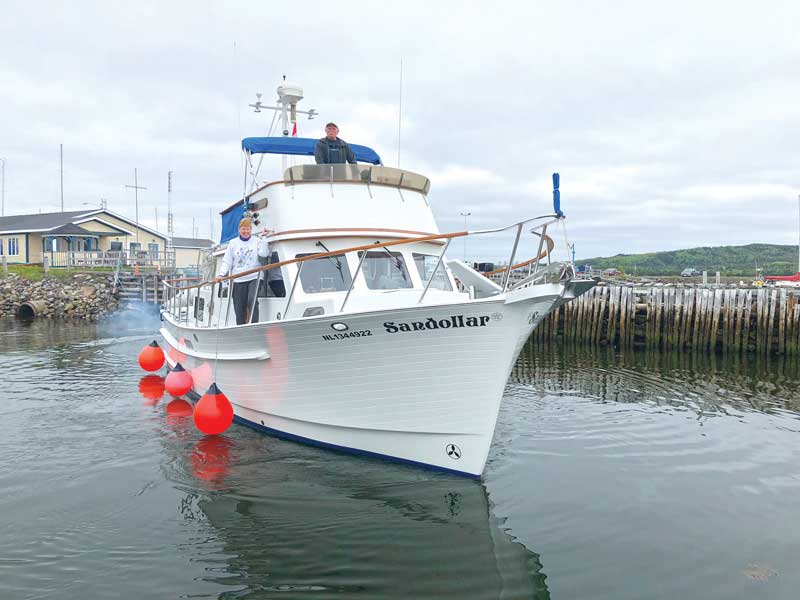Cruising in Newfoundland is distinctly different than cruising in other regions.

“Hi, I’m Dave. Thanks for helping us tie up.”
“Sure. You from away?” our shore-side helper replied, with a curious turn of word.
“Yes. I’m from Maine and Terry is from Maryland, in the States.” Dave responded.
“Nice lookin’ boat. What is she?”
Dave settled into the exchange. “She’s a Monk 36. I bought her in Lewisporte, Newfoundland, and we’re taking her to Maine.”
“Ess-b’y,” responded the fellow on the wharf, acknowledging the information with Newfie-speak that roughly corresponds to a gender-neutral form of “Yes boy.”

The exchange continued with a discussion of our trip so far and a few more details about Sandollar, the Monk 36 trawler that my wife, Peggy, and I were helping Dave Jansen move from Lewisporte, Newfoundland, to Falmouth, ME, a trip of over 1000 miles. The coastline is very unforgiving, so we traveled only during the day.
Cruising in Newfoundland is distinctly different than cruising in other regions. The towns are small, and the marinas are rare. Even larger places like St. Johns only had concrete wharfs or wooden floating docks. It is common to tie alongside a fishing boat that’s tied to the dock or wharf. We were greeted at 3:30 a.m. with the voices of fishermen on the dock when we had to tie to a fishing boat. Fortunately, that boat was not going fishing that day and we could go back to bed.

The weather around Newfoundland tends to be cloudy and cool in mid-June, when we started, but with generally good conditions. We encountered fog, icebergs, bears, bald eagles, whales, and lobster pot floats. Don’t motor close to the floats—there will be 50 feet of floating line before diving down to the pot.
There were the “new-to-us boat surprises.” The first surprise was turning on the hydraulic steering system’s autopilot. Sandollar immediately took a hard-left turn. The same thing happened when we tried the jog control. We needed to get going, so we steered by hand. The prior owners were contacted. “It’s always been a bit squirrely,” was their response. The manuals were consulted, and the wiring was checked. Sure enough, a jumper was in the wrong place on the hydraulic valve solenoid. It would always turn to port, regardless of the autopilot command, and had been that way through two prior owners.

Radar is a common-sense safety tool for peering through fog. Unfortunately, the boat’s radar died halfway through the trip, and we had to get a replacement unit shipped in.
The cabin heater, a necessity in the cool climate, would start but wouldn’t run reliably. More manual reading and wiring changes! These surprises taught us that “island mechanics” exist in cold climates, too.
There were some delightful experiences. A set of whales surfaced close enough to spritz us with their breath. The towns were colorful, and we saw many interesting vessels. We were treated to fancy teacups, lace doilies, and great food at restaurants in the French-influenced town of Bona Vista. A Newfie in an auto parts store recommended that we try cod tongues, pronounced in a way that confused us at first. We laughed about it but couldn’t get past the mental image enough to give them a try.

Our path took us to St. Johns and along the south coast. We stopped for weather in Saint Pierre Island, a territory of France, where we challenged our memory of high-school French and enjoyed scrumptious baked goods. When the weather broke, we continued to Rose Blanch for a quick overnight rest before jumping over to the Great Bras D’Or Lake, Nova Scotia, where it felt much more settled. A few days later found us in Halifax. It was a great trip!
About the Author: Terry Slattery, a graduate engineer and bluewater cruiser, is co-owner of a Leopard 40 catamaran sailboat that masquerades as a powerboat when transiting the ICW. He contributes to SpinSheet and PropTalk and publishes technical blogs at svlux.blogspot.com.